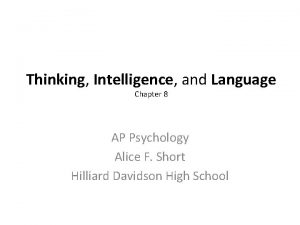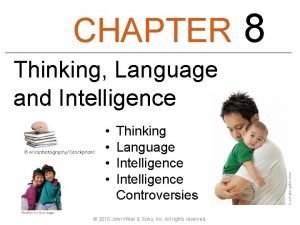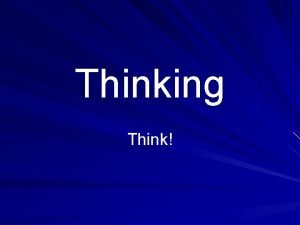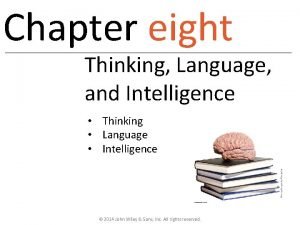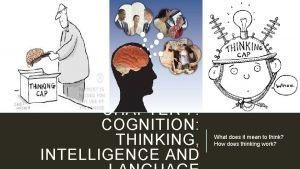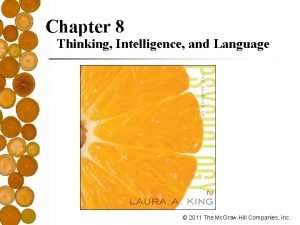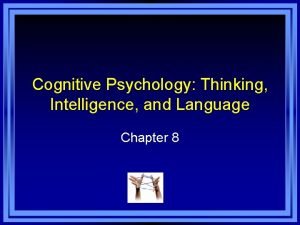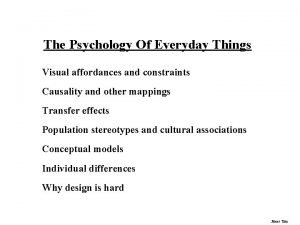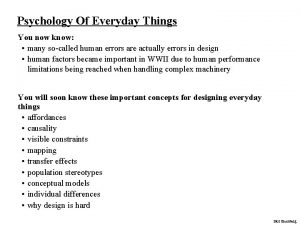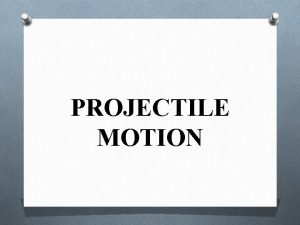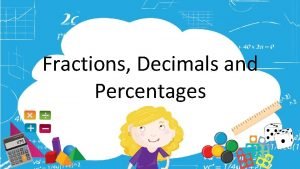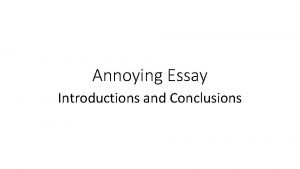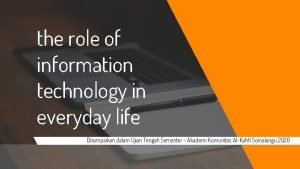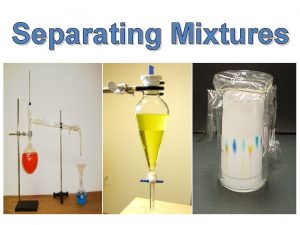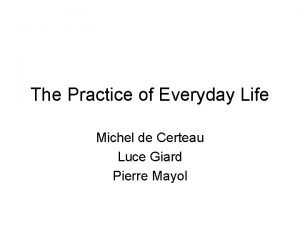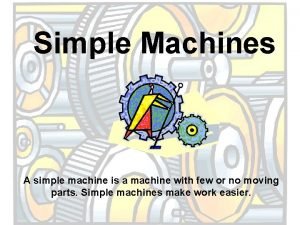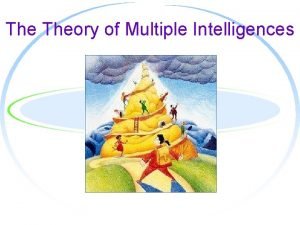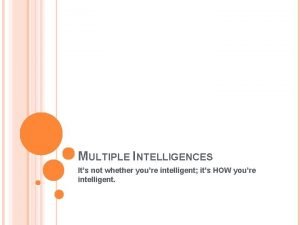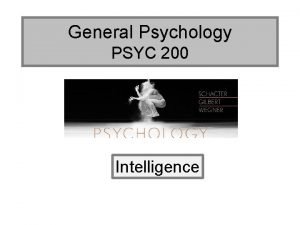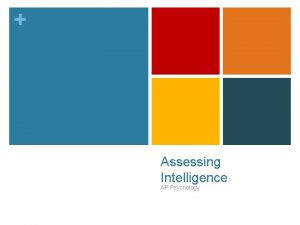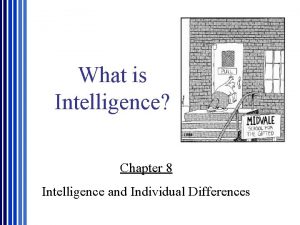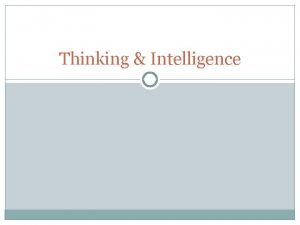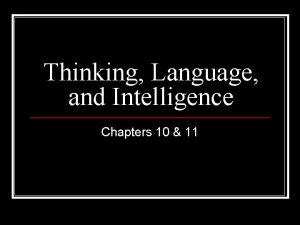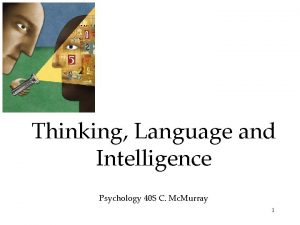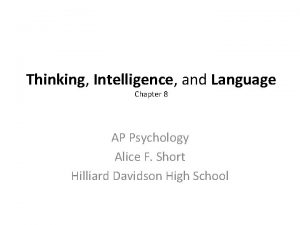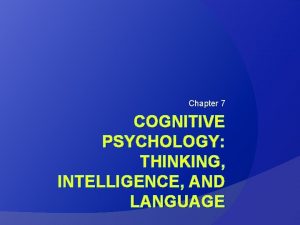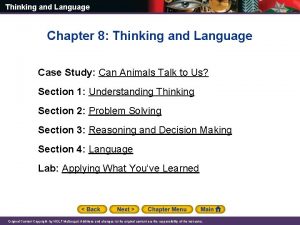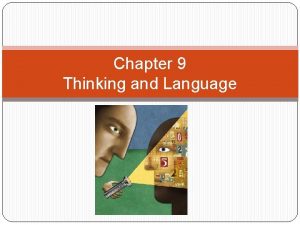Thinking Language and Intelligence Psychology in Everyday Life


































































- Slides: 66

Thinking, Language, and Intelligence Psychology in Everyday Life Copyright © 2020 by Macmillan Learning. All Rights Reserved Chapter 8 David G. Myers • C. Nathan De. Wall | Fifth

Chapter Overview Copyright © 2020 by Macmillan Learning. All Rights Reserved • Thinking • Language • Intelligence Psychology in Everyday Life David G. Myers • C. Nathan De. Wall | Fifth

• • • Concepts Solving problems Making good (and bad) decisions and judgments Thinking critically about the fear factor Thinking creatively Do other species share our cognitive skills? Psychology in Everyday Life David G. Myers • C. Nathan De. Wall | Fifth Copyright © 2020 by Macmillan Learning. All Rights Reserved Thinking

Cognition and Concepts • Simplify thinking • Formed by developing a prototype Psychology in Everyday Life David G. Myers • C. Nathan De. Wall | Fifth Copyright © 2020 by Macmillan Learning. All Rights Reserved • Cognition: All mental activities associated with thinking, knowing, remembering, and communicating • Concepts: Mental grouping of similar objects, events, ideas, or people

• Trial and error • Algorithm: A methodical, logical rule or procedure that guarantees a solution for a problem. • Heuristic: A simple thinking strategy that allows one to make judgments and solve problems efficiently. Heuristics are speedier but more error -prone than algorithms. • Insight: A sudden realization of the solution to a problem. It contrasts with strategy-based solutions. Psychology in Everyday Life David G. Myers • C. Nathan De. Wall | Fifth Copyright © 2020 by Macmillan Learning. All Rights Reserved Strategies Used to Solve Problems

The Aha! Moment Copyright © 2020 by Macmillan Learning. All Rights Reserved • A burst of right temporal lobe EEG activity (yellow area) accompanied insight solutions to word problems (Jung. Beeman et al. , 2004). • The red dots show placement of the EEG electrodes. • The light gray lines show patterns of brain activity during insight. Psychology in Everyday Life David G. Myers • C. Nathan De. Wall | Fifth

Obstacles to Problem Solving • Confirmation bias • Tendency to seek evidence for one’s ideas more eagerly than evidence against them • Functional fixation Copyright © 2020 by Macmillan Learning. All Rights Reserved • Inability to see a problem from a new perspective Psychology in Everyday Life David G. Myers • C. Nathan De. Wall | Fifth

Copyright © 2020 by Macmillan Learning. All Rights Reserved The Matchstick Problem Psychology in Everyday Life David G. Myers • C. Nathan De. Wall | Fifth

Copyright © 2020 by Macmillan Learning. All Rights Reserved Solution to the Matchstick Problem Psychology in Everyday Life David G. Myers • C. Nathan De. Wall | Fifth

Making Decisions and Judgments (part 1) • Events that readily come to mind are assumed to be common. • Such thinking can distort one’s judgments of other people. Psychology in Everyday Life David G. Myers • C. Nathan De. Wall | Fifth Copyright © 2020 by Macmillan Learning. All Rights Reserved • Intuition: Effortless, immediate, and automatic feeling or thought, as contrasted with explicit, conscious reasoning • Availability heuristic: Judging the likelihood of an event based on its availability in memory

The Fear Factor • What factors exaggerate our fear of unlikely events? Copyright © 2020 by Macmillan Learning. All Rights Reserved • Many people fear flying more than driving. Psychology in Everyday Life David G. Myers • C. Nathan De. Wall | Fifth

1. We fear what our ancestral history has prepared us to fear. 2. We fear what we cannot control. 3. We fear what is immediate. 4. We fear what is most readily available in memory. 5. We fear too little the less dramatic and ongoing threats that claim lives one by one. Psychology in Everyday Life David G. Myers • C. Nathan De. Wall | Fifth Copyright © 2020 by Macmillan Learning. All Rights Reserved Why Do We Fear the Wrong Things?

Making Decisions and Judgments (part 2) • Representativeness heuristic: Judging the likelihood of an event in terms of how well it seems to represent, or match, a particular prototype Copyright © 2020 by Macmillan Learning. All Rights Reserved • May lead to ignorance of other relevant information Psychology in Everyday Life David G. Myers • C. Nathan De. Wall | Fifth

Making Decisions and Judgments (part 3) • Overconfidence: The tendency to be more confident than correct Copyright © 2020 by Macmillan Learning. All Rights Reserved • Overestimates the accuracy of one’s beliefs and judgments • Can have adaptive value Psychology in Everyday Life David G. Myers • C. Nathan De. Wall | Fifth

Making Decisions and Judgments (part 4) • Belief perseverance: Holding beliefs and ignoring the evidence that proves them wrong • Framing: The way an issue is posed Copyright © 2020 by Macmillan Learning. All Rights Reserved • Can significantly affect decisions and judgment Psychology in Everyday Life David G. Myers • C. Nathan De. Wall | Fifth

Perils and Powers of Intuition • Recognition developed from deep and special knowledge, based on experience; implicit • Usually adaptive • Huge; constantly affecting judgments via unconscious automatic influences • Aided by deliberate, conscious thoughts Psychology in Everyday Life David G. Myers • C. Nathan De. Wall | Fifth Copyright © 2020 by Macmillan Learning. All Rights Reserved • Intuition

Creativity (part 1) • Ability to produce new and valuable ideas; requires a certain aptitude level • Convergent thinking: Narrows the available solutions to determine the single best solution to a problem Psychology in Everyday Life David G. Myers • C. Nathan De. Wall | Fifth Copyright © 2020 by Macmillan Learning. All Rights Reserved • Aptitude tests require convergent thinking.

Creativity (part 2) • Creativity tests require divergent thinking. Copyright © 2020 by Macmillan Learning. All Rights Reserved • Divergent thinking: Involves expanding the number of possible solutions • Creative thinking that moves away in different directions Psychology in Everyday Life David G. Myers • C. Nathan De. Wall | Fifth

Ingredients of Creativity (Sternberg et al. ) Expertise Imaginative thinking skills Venturesome personality Intrinsic motivation Creative environment Psychology in Everyday Life Copyright © 2020 by Macmillan Learning. All Rights Reserved • • • David G. Myers • C. Nathan De. Wall | Fifth

Process or Strategy Description Powers Perils Algorithm Methodical rule or procedure Guarantees solution Requires time and effort Heuristic Simple thinking shortcut, such as the availability heuristic (which estimates likelihood based on how easily events come to mind) Lets us act quickly and efficiently Puts us at risk for errors Insight Sudden Aha! reaction Provides instant realization of solution May not happen Confirmation bias Tendency to search for support for our own views and ignore contradictory evidence Lets us quickly recognize supporting evidence Hinders recognition of contradictory evidence Functional fixedness Inability to view problems from a new angle Focuses thinking Hinders creative problem solving Intuition Fast, automatic feelings and thoughts Is based on our experience; huge and adaptive Can lead us to overfeel and underthink Overconfidence Overestimating the accuracy of our beliefs and judgments Allows us to be happy and to make decisions easily Puts us at risk for errors Belief perseverance Ignoring evidence that proves our beliefs are wrong Supports our enduring beliefs Closes our mind to new ideas Framing Wording a question or statement so that it evokes a desired response Can influence others’ decisions Can produce a misleading result Creativity Ability to innovate valuable ideas Produces new insights and products May distract from structured, routine work Psychology in Everyday Life David G. Myers • C. Nathan De. Wall | Fifth Copyright © 2020 by Macmillan Learning. All Rights Reserved Comparing Cognitive Processes and Strategies

Research-Based Strategies to Boost Your Creative Process Psychology in Everyday Life Copyright © 2020 by Macmillan Learning. All Rights Reserved • Develop your expertise. • Allow time for ideas to develop and flourish. • Set aside time for your mind to roam freely. David G. Myers • C. Nathan De. Wall | Fifth

Do Other Species Share Our Cognitive Skills? • Formation of concepts and development of numerical skills • Display of insight and creative tool use • Invention of behaviors and transmission of cultural patterns to their observing peers and offspring Psychology in Everyday Life David G. Myers • C. Nathan De. Wall | Fifth Copyright © 2020 by Macmillan Learning. All Rights Reserved • Nonhuman animals possess the neural networks that generate consciousness.

Tool-Using Animals Psychology in Everyday Life Copyright © 2020 by Macmillan Learning. All Rights Reserved (a) One male chimpanzee in Sweden’s Furuvik Zoo was observed every morning collecting stones into a neat little pile, which later in the day he used as ammunition to pelt visitors. (b) Crows studied by Christopher Bird and Nathan Emery quickly learned to raise the water level in a tube and nab a floating worm by dropping stones into the water. David G. Myers • C. Nathan De. Wall | Fifth

• • Language acquisition and development The brain and language Thinking without language Do other species have language? Psychology in Everyday Life David G. Myers • C. Nathan De. Wall | Fifth Copyright © 2020 by Macmillan Learning. All Rights Reserved Language

Language Development (part 1) • Includes spoken, written, or signed words, and the ways one combines them to communicate meaning • Used to transmit a civilization’s knowledge from one generation to the next • Connects humans Psychology in Everyday Life David G. Myers • C. Nathan De. Wall | Fifth Copyright © 2020 by Macmillan Learning. All Rights Reserved • Language

Language Development (part 2) • Infants start without language. • They break the language they hear into individual words at 7 months and beyond. • Productive language: Ability to produce words • Matures after receptive language Psychology in Everyday Life David G. Myers • C. Nathan De. Wall | Fifth Copyright © 2020 by Macmillan Learning. All Rights Reserved • Language development moves from simple to complex. • Receptive language: Ability of infants to understand what is said to and about them

Summary of Language Development Stage 4 Babbles many speech sounds (“ah-goo”) 10 Babbling resembles household language (“ma-ma”) 12 One-word speech (“Kitty!”) 24 Two-word speech (“Get ball. ”) 24+ Rapid development into complete sentences Psychology in Everyday Life David G. Myers • C. Nathan De. Wall | Fifth Copyright © 2020 by Macmillan Learning. All Rights Reserved Month (approximate)

Language Development: Critical Period • Childhood is a critical period for language learning that gradually slows around age 7. • Late bloomers follow the sequence of language development at a faster pace. Psychology in Everyday Life Copyright © 2020 by Macmillan Learning. All Rights Reserved • Children deaf from birth • Second-language learning David G. Myers • C. Nathan De. Wall | Fifth

Copyright © 2020 by Macmillan Learning. All Rights Reserved Our Ability to Learn a New Language Diminishes With Age Psychology in Everyday Life David G. Myers • C. Nathan De. Wall | Fifth

The Brain and Language Copyright © 2020 by Macmillan Learning. All Rights Reserved • Damage to any one of several areas of the brain’s cortex can impair language. • In processing language, the brain operates by dividing its mental functions into smaller tasks. Psychology in Everyday Life David G. Myers • C. Nathan De. Wall | Fifth

Brain Activity When Hearing and Speaking Words Copyright © 2020 by Macmillan Learning. All Rights Reserved • Broca’s area: The area in the left frontal lobe that directs the muscle movements involved in speech • Wernicke’s area: The area in the left temporal lobe that deals with language comprehension and expression Psychology in Everyday Life David G. Myers • C. Nathan De. Wall | Fifth

• Mental practice relies on thinking in images. • A learned skill can be developed by watching or just imagining the physical experience. • Mental rehearsal can aid in the achievement of academic goals. • Daily process simulation • It is more effective to imagine how to reach a goal than to focus on a desired destination. Psychology in Everyday Life David G. Myers • C. Nathan De. Wall | Fifth Copyright © 2020 by Macmillan Learning. All Rights Reserved Thinking Without Language

• Animals display great powers of understanding and communicating. • Vervet monkeys sound different alarms for different predators. • A chimpanzee (named Washoe) could use about 250 signs (simple vocabularies and sentences). • Animals make signs and push buttons to get a reward. • So what do you think? Psychology in Everyday Life David G. Myers • C. Nathan De. Wall | Fifth Copyright © 2020 by Macmillan Learning. All Rights Reserved Do Other Species Have Language?

• • • What is intelligence? Assessing intelligence The nature and nurture of intelligence Intelligence across the life span Group differences in intelligence test scores Psychology in Everyday Life David G. Myers • C. Nathan De. Wall | Fifth Copyright © 2020 by Macmillan Learning. All Rights Reserved Intelligence

• Intelligence: The ability to learn from experience, solve problems, and use knowledge to adapt to new situations • General intelligence (g): The general intelligence factor that underlies specific mental abilities • Measured by every task on an intelligence test • Mental abilities are similar to physical abilities. Psychology in Everyday Life David G. Myers • C. Nathan De. Wall | Fifth Copyright © 2020 by Macmillan Learning. All Rights Reserved Intelligence and Spearman’s General Intelligence

Gardner’s Multiple Intelligences • Saw evidence of multiple intelligence in people with savant syndrome • Four in five savants are male; many have ASD. Psychology in Everyday Life David G. Myers • C. Nathan De. Wall | Fifth Copyright © 2020 by Macmillan Learning. All Rights Reserved • Intelligence consists of multiple abilities that come in different packages. • Gardner identified eight relatively independent intelligences.

Copyright © 2020 by Macmillan Learning. All Rights Reserved Gardner’s Eight Intelligences Psychology in Everyday Life David G. Myers • C. Nathan De. Wall | Fifth

Sternberg’s Three Intelligences • Analytical intelligence • School smarts: Traditional academic problem solving • Creative intelligence • Practical intelligence • Street smarts: Skill at handling everyday tasks Psychology in Everyday Life David G. Myers • C. Nathan De. Wall | Fifth Copyright © 2020 by Macmillan Learning. All Rights Reserved • Trailblazing smarts: Ability to generate novel ideas

Criticisms of Multiple Intelligence Theories • Research confirms the existence of a general intelligence factor that predicts performance on various complex tasks and in various jobs. • Researchers report a 10 -year rule. • Expert performers spend about a decade in intense and daily practice. Psychology in Everyday Life David G. Myers • C. Nathan De. Wall | Fifth Copyright © 2020 by Macmillan Learning. All Rights Reserved • Factor analysis used • Ingredients for success include ability and motivation

Emotional Intelligence: Abilities Perceiving emotions Understanding emotions Managing emotions Using emotions Copyright © 2020 by Macmillan Learning. All Rights Reserved • • Psychology in Everyday Life David G. Myers • C. Nathan De. Wall | Fifth

Theory Summary Strengths Other Considerations Spearman’s general intelligence (g) A basic intelligence predicts our abilities in many different academic areas. Different abilities, such as verbal and spatial, do have some tendency to correlate. Human abilities are too varied to be presented as a single general intelligence factor. Gardner’s multiple intelligences Our abilities are best classified into eight or nine independent intelligences, which include a broad range of skills beyond traditional school smarts. Intelligence is more than just verbal and mathematical skills. Other abilities are equally important to our human adaptability. Should all our abilities be considered intelligences? Shouldn’t some be called less vital talents? Sternberg’s triarchic theory Our intelligence is best classified into three areas that predict realworld success: analytical, creative, and practical. These three areas can be reliably measured. These three areas may be less independent than Sternberg thought and may actually share an underlying g factor. Emotional intelligence Social intelligence contributes to life success. Emotional intelligence is a key aspect, consisting of perceiving, understanding, managing, and using emotions. These four components predict social success and emotional well-being. Does this stretch the concept of intelligence too far? Psychology in Everyday Life David G. Myers • C. Nathan De. Wall | Fifth Copyright © 2020 by Macmillan Learning. All Rights Reserved Comparing Theories of Intelligence

Assessing Intelligence • Achievement test: Assesses what a person has learned • Aptitude test: Predicts a person’s future performance Psychology in Everyday Life David G. Myers • C. Nathan De. Wall | Fifth Copyright © 2020 by Macmillan Learning. All Rights Reserved • Intelligence test: Assesses an individual’s mental aptitudes and compares them with those of other people, using numerical scores

Alfred Binet: Predicting School Achievement Copyright © 2020 by Macmillan Learning. All Rights Reserved • Assumed that all children follow the same course of intellectual development, but not at the same rate • Measured each child’s mental age • Tested reasoning and problem-solving questions Psychology in Everyday Life David G. Myers • C. Nathan De. Wall | Fifth

• Adapted Binet’s tests for California school children • Established new standards for various ages • Extended upper end of test’s range • Named this revision the Stanford-Binet test Psychology in Everyday Life David G. Myers • C. Nathan De. Wall | Fifth Copyright © 2020 by Macmillan Learning. All Rights Reserved Lewis Terman: Measuring Innate Intelligence

Intelligence Quotient (IQ) • Created by William Stern • The test-taker is assigned a score that represents his or her performance relative to the average performance. Psychology in Everyday Life David G. Myers • C. Nathan De. Wall | Fifth Copyright © 2020 by Macmillan Learning. All Rights Reserved • No longer computed

Wechsler Adult Intelligence Scale (WAIS) • Created by David Wechsler • Contains verbal and performance (nonverbal) subtests • Yields an overall intelligence score and separate scores for verbal comprehension, perceptual organization, working memory, and processing speed Psychology in Everyday Life David G. Myers • C. Nathan De. Wall | Fifth Copyright © 2020 by Macmillan Learning. All Rights Reserved • Preschool and school-age child versions exist.

Three Tests of a Good Test Copyright © 2020 by Macmillan Learning. All Rights Reserved • Standardization • Reliability • Validity Psychology in Everyday Life David G. Myers • C. Nathan De. Wall | Fifth

The Normal Curve Psychology in Everyday Life Copyright © 2020 by Macmillan Learning. All Rights Reserved • Scores on aptitude tests tend to form a normal, or bellshaped, curve around an average score. • For the Wechsler scale, for example, the average score is 100. David G. Myers • C. Nathan De. Wall | Fifth

Validity of a Test • Content validity • Extent to which a test samples the behavior that is of interest • Success with which a test predicts the behavior it is designed to predict Psychology in Everyday Life David G. Myers • C. Nathan De. Wall | Fifth Copyright © 2020 by Macmillan Learning. All Rights Reserved • Predictive validity

High and Low Scorers of Intelligence Tests • The validity and significance of any test can be assessed by comparing people who score at the two extremes of the normal curve. • Low extreme: Scores below 70 • Intellectual disability. Psychology in Everyday Life Copyright © 2020 by Macmillan Learning. All Rights Reserved • High extreme: Scores above 130 David G. Myers • C. Nathan De. Wall | Fifth

Diagnosis of Intellectual Disability 1. An intelligence test score indicating performance that is in the lowest 3 percent of the population, or about 70 or below 2. Difficulty adapting to the normal demands of independent living, as expressed in three areas, or skills: conceptual, social, and practical Psychology in Everyday Life David G. Myers • C. Nathan De. Wall | Fifth Copyright © 2020 by Macmillan Learning. All Rights Reserved • To be diagnosed with an intellectual disability, a person must meet two criteria:

Nature and Nurture of Intelligence • Heritability: Portion of variation among people in a group that can be attributed to genes • The most genetically similar people have the most similar intelligence scores (Mc. Gue et al. , 1993). • 1. 00 indicates a perfect correlation. • Zero indicates no correlation at all. Psychology in Everyday Life David G. Myers • C. Nathan De. Wall | Fifth Copyright © 2020 by Macmillan Learning. All Rights Reserved • Varies depending on the population and the environment

Environment and Intelligence • Biological parents, adoptive siblings • The shared environment exerts a modest influence on intelligence test scores. Psychology in Everyday Life David G. Myers • C. Nathan De. Wall | Fifth Copyright © 2020 by Macmillan Learning. All Rights Reserved • Fraternal twin scores are as genetically similar as any other two siblings. • Adoption studies help assess the influence of genes and environment on intelligence.

Copyright © 2020 by Macmillan Learning. All Rights Reserved Intelligence: Nature and Nurture Psychology in Everyday Life David G. Myers • C. Nathan De. Wall | Fifth

In Verbal Ability, Whom Do Adopted Children Resemble? Psychology in Everyday Life Copyright © 2020 by Macmillan Learning. All Rights Reserved • As the years went by in their adoptive families, children’s verbal ability scores became more like their biological parents’ scores (data from Plomin & De. Fries, 1998). David G. Myers • C. Nathan De. Wall | Fifth

• Genes shape the experiences that shape us. • In some gene–environment interactions, small genetic advantages can trigger social experiences that multiply or depress original skills. • Where environments vary widely, environmental differences are more predictive of intelligence scores. • Intelligence also depends on personal beliefs and motivation. Psychology in Everyday Life David G. Myers • C. Nathan De. Wall | Fifth Copyright © 2020 by Macmillan Learning. All Rights Reserved Gene–Environment Interactions

Intelligence Across the Life Span: Stability or Change • Cross-sectional studies: Compare people of different ages with one another • Longitudinal studies: The same people are restudied and retested over a long period • With age, one’s knowledge and mental agility change. Psychology in Everyday Life David G. Myers • C. Nathan De. Wall | Fifth Copyright © 2020 by Macmillan Learning. All Rights Reserved • Cross-sectional and longitudinal studies demonstrate that intelligence endures.

Intelligence Endures Psychology in Everyday Life Copyright © 2020 by Macmillan Learning. All Rights Reserved • When Ian Deary and his colleagues (2004) retested 80 -year-old Scots, using an intelligence test they had taken as 11 -year-olds, their scores across seven decades had a correlation of +0. 66. • When 106 survivors were again retested at age 90, the correlation with their age 11 scores was +0. 54 (Deary et al. , 2013). David G. Myers • C. Nathan De. Wall | Fifth

Crystal and Fluid Intelligence • Crystallized intelligence • Accumulated knowledge and verbal skills • Increases with age • Ability to reason speedily and abstractly • Decreases with age Psychology in Everyday Life David G. Myers • C. Nathan De. Wall | Fifth Copyright © 2020 by Macmillan Learning. All Rights Reserved • Fluid intelligence

Copyright © 2020 by Macmillan Learning. All Rights Reserved With Age, We Lose and We Win Psychology in Everyday Life David G. Myers • C. Nathan De. Wall | Fifth

Group Differences and Similarities in Intelligence Test Scores: Gender (part 1) • Similarities • Few gender differences in math computation and overall math performance • Social expectations and opportunities matter. • A small gender-related math gap is found in genderequal cultures. Psychology in Everyday Life David G. Myers • C. Nathan De. Wall | Fifth Copyright © 2020 by Macmillan Learning. All Rights Reserved • Effects of culture

Group Differences and Similarities in Intelligence Test Scores: Gender (part 2) • Have higher mental ability scores • Outnumber girls at the low extreme and at the high extreme Psychology in Everyday Life • Are better emotion detectors • Are more sensitive to touch, taste, and color David G. Myers • C. Nathan De. Wall | Fifth Copyright © 2020 by Macmillan Learning. All Rights Reserved • Boys outperform girls • Girls outpace boys in in tests of spatial spelling, verbal ability and complex fluency, and locating math problems. objects.

• Racial and ethnic groups differ in their average intelligence test scores. • High-scoring people and groups are more likely to achieve high levels of education and income. • Group differences provide a poor basis for judging individuals. Psychology in Everyday Life David G. Myers • C. Nathan De. Wall | Fifth Copyright © 2020 by Macmillan Learning. All Rights Reserved Group Differences and Similarities in Intelligence Test Scores: Race and Ethnicity

Race and Ethnicity • Genetics research reveals humans are remarkably alike. • Schools and culture matter. • In different eras, different ethnic groups have experienced golden ages—periods of remarkable achievement. Psychology in Everyday Life David G. Myers • C. Nathan De. Wall | Fifth Copyright © 2020 by Macmillan Learning. All Rights Reserved • Race is not a clearly defined biological category. • Within the same population, there are generation-togeneration differences in test scores.

Are Intelligence Test Questions Biased? • The scientific meaning of bias hinges on a test’s validity. • Predictive validity for all groups of test-takers • Culture-fair aptitude tests Copyright © 2020 by Macmillan Learning. All Rights Reserved • Test-taker expectations • Stereotype threat • Self-affirmation exercises Psychology in Everyday Life David G. Myers • C. Nathan De. Wall | Fifth

• Differences are variations of human adaptability. • Life’s great achievements result not only from abilities (and fair opportunity) but also from motivation. • Competence + Diligence = Accomplishment Psychology in Everyday Life David G. Myers • C. Nathan De. Wall | Fifth Copyright © 2020 by Macmillan Learning. All Rights Reserved There Are Many Ways of Being Successful
 Ap psych chapter 8
Ap psych chapter 8 When you group subcategories within broader concepts
When you group subcategories within broader concepts Intuition ap psychology definition
Intuition ap psychology definition How do we use critical thinking in everyday life
How do we use critical thinking in everyday life Psychology in everyday life myers
Psychology in everyday life myers Thinking language and intelligence
Thinking language and intelligence Chapter 7 cognition thinking intelligence and language
Chapter 7 cognition thinking intelligence and language Chapter 7 quiz cognition thinking intelligence and language
Chapter 7 quiz cognition thinking intelligence and language Thinking affects our language which then affects our
Thinking affects our language which then affects our Chapter 8 thinking language and intelligence
Chapter 8 thinking language and intelligence Thinking intelligence and language
Thinking intelligence and language The psychology of everyday things
The psychology of everyday things Psychology of everyday things
Psychology of everyday things Psychology of everyday things
Psychology of everyday things Chapter 6 section 2 supply and demand in everyday life
Chapter 6 section 2 supply and demand in everyday life Inertia in life
Inertia in life Examples of social interaction in everyday life
Examples of social interaction in everyday life Examples of complex machines used in everyday life
Examples of complex machines used in everyday life Importance of projectile motion in our daily life
Importance of projectile motion in our daily life Pneumatic systems examples
Pneumatic systems examples Cool physical changes
Cool physical changes Rhetorical strategies
Rhetorical strategies Where can you find percentages in everyday life
Where can you find percentages in everyday life Application of parabola in real life
Application of parabola in real life Chemical reactions in everyday life
Chemical reactions in everyday life How to name acids
How to name acids Vital information for your everyday life
Vital information for your everyday life Daily life real life polynomial problems
Daily life real life polynomial problems Nonassociative learning definition
Nonassociative learning definition Example of economic enigma
Example of economic enigma Measurement in everyday life
Measurement in everyday life Things that annoy me essay
Things that annoy me essay How is algebra used in everyday life
How is algebra used in everyday life Examples of mercy in everyday life
Examples of mercy in everyday life Examples of social interaction in everyday life
Examples of social interaction in everyday life Application of scientific notation in real life
Application of scientific notation in real life 10 benedictine values
10 benedictine values Ethos pathos logos in everyday life
Ethos pathos logos in everyday life Role of information technology in our daily life
Role of information technology in our daily life What happens in evaporation
What happens in evaporation Biotechnology examples in everyday life
Biotechnology examples in everyday life How is pascal's principle used in everyday life
How is pascal's principle used in everyday life The practice of everyday life
The practice of everyday life Wagon simple machine
Wagon simple machine Newtons three law
Newtons three law Place value in everyday life
Place value in everyday life Newtons 2nd law of motion
Newtons 2nd law of motion Examples of levers in everyday life
Examples of levers in everyday life Total internal reflection in daily life
Total internal reflection in daily life Middle colony clothing
Middle colony clothing Unbalanced force
Unbalanced force Social thinking and social influence
Social thinking and social influence Social thinking and social influence
Social thinking and social influence Positive thinking vs negative thinking examples
Positive thinking vs negative thinking examples Thinking about your own thinking
Thinking about your own thinking Linear thinking vs holistic thinking
Linear thinking vs holistic thinking Perbedaan critical thinking dan creative thinking
Perbedaan critical thinking dan creative thinking Thinking about you thinking about me
Thinking about you thinking about me Practical intelligence ap psychology
Practical intelligence ap psychology Interpersonal inteligence
Interpersonal inteligence Naturalistic intelligence examples
Naturalistic intelligence examples Celebrities with logical-mathematical intelligence
Celebrities with logical-mathematical intelligence Questions about intelligence psychology
Questions about intelligence psychology Stanford-binet psychology
Stanford-binet psychology Crystallized intelligence psychology definition
Crystallized intelligence psychology definition The ability to produce novel and valuable ideas
The ability to produce novel and valuable ideas Deindividuation psychology definition
Deindividuation psychology definition
